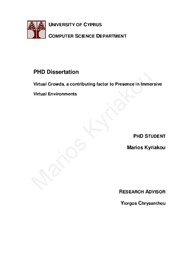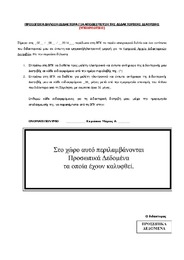| dc.contributor.advisor | Chrysanthou, Yiorgos | en |
| dc.contributor.author | Kyriakou, Marios A. | en |
| dc.coverage.spatial | Κύπρος | el |
| dc.coverage.spatial | Cyprus | en |
| dc.creator | Kyriakou, Marios A. | en |
| dc.date.accessioned | 2014-08-07T09:57:21Z | |
| dc.date.accessioned | 2017-08-03T10:45:37Z | |
| dc.date.available | 2014-08-07T09:57:21Z | |
| dc.date.available | 2017-08-03T10:45:37Z | |
| dc.date.issued | 2014-06 | |
| dc.date.submitted | 2014-06-14 | |
| dc.identifier.uri | https://gnosis.library.ucy.ac.cy/handle/7/39578 | en |
| dc.description | Includes bibliographical references (p. 103-111). | en |
| dc.description | Number of sources in the bibliography: 110 | en |
| dc.description | Thesis (Ph. D.) -- University of Cyprus, Faculty of Pure and Applied Sciences, Department of Computer Science, 2014. | en |
| dc.description | The University of Cyprus Library holds the printed form of the thesis. | en |
| dc.description.abstract | Καθώς η χρήση των πολυμέσων και της τεχνολογίας 3 διαστάσεων αυξάνεται σε πολλούς τομείς της ζωής μας, οι απαιτήσεις μας για περισσότερο "ρεαλισμό" επίσης ανεβαίνουν. Στα περισσότερα συστήματα εικονικής πραγματικότητας υπάρχουν εικονικοί άνθρωποι που κινούνται και αλληλεπιδρούν μεταξύ τους και ο χρήστης αναμένει να τους δει να συμπεριφέρονται όπως οι πραγματικοί άνθρωποι χωρίς ασυνήθιστα φαινόμενα (συγκρούσεις κλπ).
Υπάρχουν αρκετές προσεγγίσεις για το θέμα της προσομοίωσης πλήθους ανθρώπων, αλλά ο σχεδιασμός και η δημιουργία εικονικών πληθών, σε θέματα προσομοίωσης και κίνησης, είναι ακόμα μια πρόκληση για τους ερευνητές. Η δυσκολία έγκειται στην πολυπλοκότητα της συνολικής ανθρώπινης συμπεριφοράς. Ειδικά, αν προσθέσουμε αριθμό οντοτήτων στο περιβάλλον και συμπεριλάβουμε αλληλεπιδράσεις μεταξύ τους σχηματίζοντας ένα πλήθος, τότε η πολυπλοκότητα του συστήματος αυξάνεται εκθετικά. Παράλληλα, δεν υπάρχει αρκετή έρευνα που να εξετάζει πώς ένας χρήστης μπορεί να επηρεαστεί από εικονικά πλήθη σε ένα Εικονικό Περιβάλλον Εμβύθισης (ΕΠΕ) και ποιοι είναι οι κύριοι παράγοντες σχετικά με το εικονικό πλήθος που επηρεάζουν το συναίσθημα της παρουσίας του χρήστη που είναι εμβυθισμένος σε ένα ΕΠΕ. Αυτή η διατριβή εξετάζει τη βελτίωση της ποιότητας της προσομοίωσης ενός πλήθους καθώς και τα κύρια χαρακτηριστικά συμπεριφοράς που πρέπει ένα ρεαλιστικό εικονικό πλήθος να έχει.
Η πρώτη συνεισφορά της διατριβής είναι μια καινοτόμα προσέγγιση στο πρόβλημα της πλοήγησης πλήθους ανθρώπων. Η μέθοδος που παρουσιάζεται είναι μια τεχνική που οδηγείται από δεδομένα και βασίζεται στις αρχές της σύνθεσης επιφάνειας, όπου διαδρομές πλοήγησης πλήθους παράγονται χρησιμοποιώντας παραδείγματα από βίντεο πραγματικών ανθρώπων. Η προσομοίωση της πλοήγησης πλήθους δεν γίνεται για κάθε άνθρωπο ξεχωριστά, αλλά ολόκληρες περιοχές συνθέτονται που μπορεί να περιέχουν αριθμό ανθρώπων για κάποιο χρονικό διάστημα. Αυτό έχει τη δυνατότητα να "συλλάβει" καλύτερα τις αλληλεπιδράσεις μεταξύ γειτονικών ανθρώπων.
Υποθέτοντας ότι έχουμε μια ικανοποιητική μέθοδο για την πλοήγηση του πλήθους, εξετάζουμε ποια άλλα χαρακτηριστικά σε σχέση με τη συμπεριφορά πρέπει να παρουσιάζουν τα εικονικά πλήθη και πώς η συμπεριφορά του χρήστη επηρεάζεται από τα εικονικά πλήθη σε ένα ΕΠΕ. Σχεδιάζοντας και διεξάγοντας εξειδικευμένα πειράματα, βρήκαμε ότι η ενσωμάτωση αποφυγής συγκρούσεων μεταξύ του χρήστη και του εικονικού πλήθους δεν εγγυάται ότι η αληθοφάνεια του συστήματος εικονικής πραγματικότητας θα αυξηθεί ή ότι θα είναι πιο ευχάριστο στη χρήση. Αντιθέτως, η αποφυγή συγκρούσεων από μόνη της, ακόμη και εάν είναι ένας σημαντικός παράγοντας της ρεαλιστικότητας του εικονικού πλήθους, μπορεί να προκαλέσει ένα αίσθημα δυσφορίας κάτω από κάποιες συνθήκες. Βρήκαμε ότι εάν η πλοήγηση του πλήθους συνοδευτεί με μικρές βασικές αλληλεπιδράσεις μεταξύ του πλήθους και του χρήστη, τότε η αληθοφάνεια και το συναίσθημα της άνεσης στο σύστημα της εικονικής πραγματικότητας αυξάνεται, ενισχύοντας το συναίσθημα της παρουσίας.
Πολλές εφαρμογές σε ΕΠΕ βασίζονται στην ώθηση του χρήστη να εμπλακεί πιο ενεργά στο περιβάλλον. Διεξάγοντας μια δεύτερη σειρά από πειράματα, εξετάσαμε τους παράγοντες που προκαλούν ένα πιο δυνατό συναίσθημα παρουσίας στο χρήστη σε ένα ΕΠΕ με εικονικούς ανθρώπους και τον ενθαρρύνουν να είναι πιο ενεργός. Τα αποτελέσματα έδειξαν ότι εάν το εικονικό πλήθος αλληλεπιδρά με το χρήστη, τότε ο χρήστης τείνει να παρεμβαίνει πιο πολύ σε ένα περιστατικό και έχει πιο δυνατά συναισθήματα από ότι όταν δεν υπάρχουν αλληλεπιδράσεις. Ακόμα ένα ενδιαφέρον εύρημα είναι ότι εάν ο χρήστης ανήκει σε κάποιο γκρουπ από εικονικούς ανθρώπους, τότε η πιθανότητα του χρήστη να παρέμβει και να συμμετάσχει σε κάποιο περιστατικό ανεβαίνει.
Συνολικά, σε αυτή τη διατριβή προτείνουμε μια καινοτόμα τεχνική για την πλοήγηση πλήθους ανθρώπων και μελετούμε τα χαρακτηριστικά συμπεριφοράς που πρέπει να έχει ένα εικονικό πλήθος, σε σχέση με την εμπειρία του χρήστη, για να προσομοιώσουμε επιτυχώς εικονικά πλήθη ανθρώπων σε ένα σύστημα εμβύθισης εικονικής πραγματικότητας. | el |
| dc.description.abstract | As the use of entertainment multimedia and 3D technology increases in many sectors of our life, the expectation for more “realism” from the average user also grows higher. In most virtual reality systems there are virtual humans moving and interacting with each other, and the user expects to see them behaving as real people do, without any unusual effects (collisions etc.).
There are numerous approaches proposed for crowd simulation, but designing and developing virtual crowds, in terms of simulation and animation, is still a challenge for researchers. The difficulty lies in the complexity of the overall human behavior. Especially, if we add more entities in the environment, including interactions between them, forming a crowd, the complexity of the modeled system is increased exponentially. Furthermore, there is not sufficient research that studies how a user is being affected by virtual crowds in an Immersive Virtual Environment (IVE) and what are the main factors, in terms of virtual crowd, that affect the feeling of presence of the user who is immersed in an IVE. This thesis is concerned both with improving the quality of crowds simulation as well as with examining the main behavior characteristics that a believable virtual crowd should have.
Our first contribution is a novel approach for the crowd navigation problem. Our method is a data driven technique based on the principles of texture synthesis, where crowd navigation paths are produced based on example data, coming from real-world video footage of people. The simulation of the crowd navigation is not done for each human individually, but whole spatiotemporal areas are being synthesized that may contain several humans inside. This has the possibility of capturing better the interaction between neighboring humans.
Assuming that we have a satisfactory method for crowd navigation, we study what other behavioral characteristics should virtual crowds have and how the user’s behavior is being affected by virtual crowds in an IVE. Designing and conducting purpose-developed experiments, we found that facilitating collision avoidance between the user and the virtual crowd does not guarantee that the plausibility of the VR system will be raised or that it will be more pleasing to use. On the contrary, collision avoidance by itself, even if it is a significant factor of lifelikeness of the virtual crowd, could accommodate a feeling of discomfort under certain circumstances. We found that when crowd navigation is accompanied with basic interaction between the user and the virtual crowd, such as verbal salutations, look-at, waving and other gestures, both the plausibility and feeling of comfort in the VR system are increased, enhancing the sense of presence.
Numerous immersive VR (IVR) applications rely on user motivation to be actively involved in the environment. Conducting a second series of experiments, we examined the factors that cause a stronger feeling of presence to the user in a populated IVE and encourage the user to be more active. The results of the experiments show that if the virtual crowd is interacting with the user, then the user tends to intervene more to an incident and have stronger feelings than in a non-interactive scenario. Another interesting finding is that if the user belongs to a group of virtual people, then the possibility of the user intervening and participating in an incident is raised.
Overall, in this dissertation we propose a novel technique for crowd navigation and study what attributes of behavior are important to be integrated on the virtual crowd, towards the user’s experience, in order to successfully simulate crowds in an IVR system. | en |
| dc.format.extent | xiv, 143 p. : col. ill. ; 30 cm. | en |
| dc.language.iso | eng | en |
| dc.publisher | Πανεπιστήμιο Κύπρου, Σχολή Θετικών και Εφαρμοσμένων Επιστημών / University of Cyprus, Faculty of Pure and Applied Sciences | |
| dc.rights | info:eu-repo/semantics/openAccess | en |
| dc.rights | Open Access | en |
| dc.subject.lcsh | Virtual reality | en |
| dc.subject.lcsh | Computer graphics | en |
| dc.subject.lcsh | Human-computer interraction | en |
| dc.title | Virtual crowds, a contributing factor to presence in immersive virtual environments | en |
| dc.title.alternative | Εικονικά πλήθη, ένας παράγοντας που συνεισφέρει στο συναίσθημα της παρουσίας σε εικονικά περιβάλλοντα εμβύθισης | el |
| dc.type | info:eu-repo/semantics/doctoralThesis | en |
| dc.contributor.committeemember | Χρυσάνθου, Γιώργος | el |
| dc.contributor.committeemember | Παττίχης, Κωνσταντίνος | el |
| dc.contributor.committeemember | Χριστοδούλου, Χριστάκης | el |
| dc.contributor.committeemember | Μανιά, Αικατερίνη | el |
| dc.contributor.committeemember | Chrysanthou, Yiorgos | en |
| dc.contributor.committeemember | Pattichis, Constantinos | en |
| dc.contributor.committeemember | Christodoulou, Christakis | en |
| dc.contributor.committeemember | Mania, Katerina | en |
| dc.contributor.committeemember | Loscos, Celine | en |
| dc.contributor.department | Πανεπιστήμιο Κύπρου, Σχολή Θετικών και Εφαρμοσμένων Επιστημών, Τμήμα Πληροφορικής | el |
| dc.contributor.department | University of Cyprus, Faculty of Pure and Applied Sciences, Department of Computer Science | en |
| dc.subject.uncontrolledterm | ΓΡΑΦΙΚΑ ΥΠΟΛΟΓΙΣΤΩΝ | el |
| dc.subject.uncontrolledterm | ΠΡΟΣΟΜΟΙΩΣΗ ΠΛΗΘΟΥΣ | el |
| dc.subject.uncontrolledterm | ΕΙΚΟΝΙΚΑ ΠΕΡΙΒΑΛΛΟΝΤΑ ΕΜΒΥΘΙΣΗΣ | el |
| dc.subject.uncontrolledterm | ΕΙΚΟΝΙΚΟ ΠΛΗΘΟΣ | el |
| dc.subject.uncontrolledterm | ΠΑΡΟΥΣΙΑ | el |
| dc.subject.uncontrolledterm | COMPUTER GRAPHICS | en |
| dc.subject.uncontrolledterm | CROWD SIMULATION | en |
| dc.subject.uncontrolledterm | IMMERSIVE VIRTUAL ENVIRONMENTS | en |
| dc.subject.uncontrolledterm | VIRTUAL CROWD | en |
| dc.subject.uncontrolledterm | PRESENCE | en |
| dc.identifier.lc | QA76.9.H85K97 2014 | en |
| dc.author.faculty | Σχολή Θετικών και Εφαρμοσμένων Επιστημών / Faculty of Pure and Applied Sciences | |
| dc.author.department | Τμήμα Πληροφορικής / Department of Computer Science | |
| dc.type.uhtype | Doctoral Thesis | en |
| dc.rights.embargodate | 2017-06-02 | |
| dc.contributor.orcid | Chrysanthou, Yiorgos [0000-0001-5136-8890] | |


